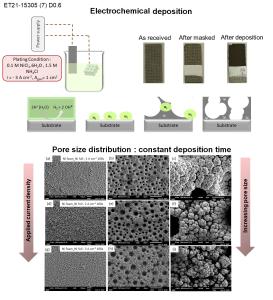Toward next generation 3D printed materials for space applications: hierarchical nano-porous structures with engineered macro-architectures

The main goal of this project was to fabricate porous electrodes used in fuel cells. A porous electrode consists of a catalyst layer (CL), microporous layer (MPL) and gas diffusion layer (GDL). GDLs are conventionally made of carbon paper or cloth. However, there are several drawbacks, including degregation in alkalin media, deformation, and consequently, closure of pores under compression, and randomness of pore charactristics (e.g., pore size and distribution). As an alternative, metallic GDLs with much greater mechanical strengths have recently been introduced for alkalin environements. Porous metallic materials are conventionally produced by powder/fiber sintering, and foaming. However, these processes are unable to precisely control pore size, morphology, and distribution, limiting the performance of the resultant systems. Thus, there is a need for developing new material sets with specific micro/macro-structures and surface properties to enable the next-generation of electrochemical technologies. To overcome these challenges, laser powder bed fusion (LPBF), as a common additive manufacturing (AM) method with the highest spatial resolution, was used to control the formation and characteristics of pores in Ti-6Al-4V and Inconel 718 (In718) GDLs by manipulating laser parameters and pore geometries. Following LPBF, an additional step of the electrodeposition of porous Ni catalyst was also performed to improve electrochemical efficiency. Hydrogen and oxygen evolution reactions (HER and OER) were examined in a classical three electrode cell to test the electrochemical performance of the electrodes.
